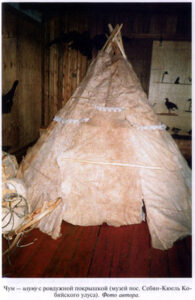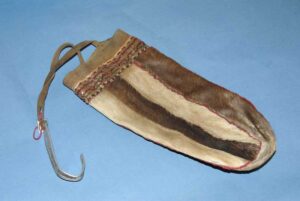Эвенские поселения и жилища

According to ethnographic data, at the end of the 19th - beginning of the 20th centuries, there are three types of settlements among the Evens: camping-ground of reindeer herders and hunters, settlements of settled residents and zaimkas (small settlements).
Nomadic camps are characteristic of nomadic Evens, whose main industry is reindeer husbandry, and additional - land hunting in the taiga, mountains and fishing.
Стойбища, представляющие собой небольшие временные поселения, обычно располагались на маршрутах кочевий оленьих стад. В нем обитало, несколько семей (2 –3 семьи), чаще всего родственных. Стоянки становились многолюдными лишь весной (тогда собиралось до 19 чумов), еще больше людей собиралось на праздники, общие собрания и встречи родственников.
В зависимости от сезона, местных условий, характера оленьих пастбищ и хозяйственных занятий на одном стойбище жили несколько дней или недель и даже месяцев. Так, эвенки и эвены чаще всего жили на одном месте 4 – 5 дней, у эвенов самые длительные стоянки (от 1 до 2-х месяцев) были приурочены к гону, отелу оленей или особенно сильным морозам.
Settlements of settled Evens and zaimkas were built in places convenient for fishing and sea animals, as well as in the vicinity of already existing settlements. Over time, some of them turned into large settlements. Usually 1-3 households settled on such settlements. The appearance of zaimka was often preceded by a pretty long period of semi-sedentary life.

The nomadic way of life of the Evens led to the spread of traditional dwellings – ilumu (chum) and chorama-du (yurt). The chum-ilumu has a conical structure made of poles (with a certain fastening of the supporting poles); chorama-du – Even cylindrical-conical dwelling. чум – илуму представляет собой коническое сооружение из жердей (с определенным креплением опорных жердей); чорама-дю – эвенское цилиндро-коническое жилище.
The Even chum belongs to the Tungus type, which is characterized by four ways of connecting the main support poles of the chum: 2-3-4 main poles abut with their tops, connected with the help of left twigs or a rope made of rovduga, which are tied or crossed; the hearth circle is attached to one horizontal pole, fastened to the poles of the chum and a special pole inside the chum.
Since the end of the 19th century, there has been a distribution of the cylindrical-conical type of dwelling of the Even chorama-du. It is believed that the yurt first appeared among the Evens on the northern part of the Okhotsk coast in the 18th and early 19th centuries due to the rapid development of reindeer husbandry and the growth in the number of individual families. The design of the Even chorama-du is somewhat similar to the design of the Chukchi and Koryak yarangs. чорама-дю In these types of dwellings, we note the presence of a cylindrical lower frame with a height of 1,5 meters with poles attached to it, forming a cone-shaped roof, which sharply increases the internal volume of the dwelling.
Inside the dwelling there were only the essentials for life, items that the Even family used in everyday life: dishes and utensils, baby cradles, bedding, sleeping bags made of reindeer skins, as well as equipment for a reindeer-hunter, stored in a strictly defined place (on the right and to the left of the entrance to the chum), a mobile table and bags for clothes. The placement of household items was traditionally assigned to certain places. Each family member adhered to the traditionally established order of moving and staying in the chum, which was extremely important with constant migrations, thereby harmony reigned in the Even's dwelling, there was no chaos and disorder.
To the left of the front door (urkepen) was the choonal – a place for storing dishes and food. The bed of the mistress of the dwelling was spread over his headboard. уркэпэн – располагался чоонал – место для хранения посуды и еды. Изголовьем к нему стелилась постель хозяйки жилища. Муж отдельной постели не имел, а располагался в противоположном краю семейной постели. Справа от уркэпэн располагались дети. Почетное место в эвено-эвенкийском чуме или юрте считается “мал” или “малу” – сторона против входа за очагом.
 Yurts have long been an indispensable element of the Even settlements, especially in the northern treeless regions of Yakutia. So, already in the early 1930-s the Evens of the Tompo district quit using the yurt, but it remained for a long time among the Evens of the Okhotsk coast. Until the end of the 1960-s the yurt was used only by the Evens of the Berezov-Rassokha region. Until now, the yurt is preserved by the tundra reindeer herders of northeastern Yakutia.
Yurts have long been an indispensable element of the Even settlements, especially in the northern treeless regions of Yakutia. So, already in the early 1930-s the Evens of the Tompo district quit using the yurt, but it remained for a long time among the Evens of the Okhotsk coast. Until the end of the 1960-s the yurt was used only by the Evens of the Berezov-Rassokha region. Until now, the yurt is preserved by the tundra reindeer herders of northeastern Yakutia.
Traditional plague dwellings fell out of use in the 60-s of the last century. At present times, they used as a place for smoking meat and skins (for example, in the reindeer estates of the Kobyai district); tarpaulin material is used to cover them
The yurt is still preserved by the tundra reindeer breeders of northeastern Yakutia. The reason for keeping it, there is strong piercing winds prevailing on the coast of the Arctic Ocean in winter. The main type of temporary dwelling, besides log cabins, among the Evens-reindeer herders is a gable tent, which is characterized by ease and convenience during transportation.
Dr. E.K. Alekseeva
Хозяйственные постройки
У эвенов хозяйственными постройками служили срубные амбары и лабазы, изгороди и загоны для оленей, вешала под мясо, рыбу и одежду, применяемые и в настоящее время в оленеводческих стадах. Их отличительная особенность – коническое покрытие, характерное для тунгусской традиции. Амбары и лабазы (в разных районах их называли по-разному: нэку, пури, биркэн, окин) сооружались из бревен на столбах или спиленных деревьях. Они предназначались для долговременного хранения вещей, которыми пользовались в определенные сезоны года, а также непортящихся продуктов.
Возле чума эвены ставили временный лабаз – на двух бревнах поперечно ложили шесты. На нём хранились вещи и продукты, которые брали с собой во время перекочевки. В тундре, где строительного леса нет, хранение ненужных по сезону вещей практиковалось чаще всего на грузовых нартах, укрытых ровдужными покрышками чумов. Широко распространенными были вешала для мяса, рыбы и одежды.
Dr. E.K. Alekseeva



